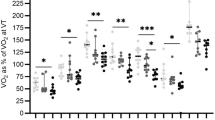Summary
A total of 257 healthy children (140 boys, 117 girls) varying in age from 5.7 to 18.5 years underwent graded exercise tests on a treadmill. Cardiorespiratory endurance capacity was assessed by determination of the ventilatory threshold, which was defined as the highest exercise intensity before a disproportionate increase occurred in pulmonary ventilation (\(\dot V\) E) relative to oxygen uptake (\(\dot V_{o_2 } \)). The purpose of the present study was to investigate the relationship between the habitual level of physical activity (HLPA) and the cardiorespiratory endurance capacity in children. The HLPA was assessed by a standardized questionnaire. In boys and girls HLPA increased gradually with advancing age. For the group as a whole, the boys reached the highest values for HLPA. The most active boys reached the highest value for ventilatory threshold and the lowest value was found in the less active ones, except for the age span of 12–16 years. It is concluded that more active boys showed a higher cardiorespiratory endurance capacity, as assessed by the ventilatory threshold, compared to less active ones, except during puberty. It can be postulated that during puberty this effect may be overruled by the influence of other more dominant growth-related factors. In girls, because HLPA was rather low, there was no discriminative effect of HLPA on exercise performance, as would be expected.
Similar content being viewed by others
References
Årand P, Rodahl K (1977) Textbook of Work Physiology, 2nd edn. McGraw-Hill, New York
Blimkie C, Cunningham D, Nichol P (1980) Gas transport capacity and echocardiographically determined cardiac size in children. J Appl Physiol Respir Environ Exerc Physiol 49:994–999
Caiozzo V, Davis J, Ellis J, Azus J, Vandagriff R, Prietto C, McMaster W (1982) A comparison of gas exchange indices used to detect the anaerobic threshold. J Appl Physiol Respir Environ Exerc Physiol 53:1184–1189
Chandramouli B, Ehmke K, Lauer R (1975) Exercise induced electrocardiographic changes in children with congenital aortic stenosis. J Pediatr 87:725–730
Cunningham D, Van Waterschoot B, Paterson D, Lefcoe M, Sangal S (1977) Reliability and reproducibility of maximal oxygen uptake measurements in children. Med Sci Sports 9:104–108
Davies C, Barnes C, Godfrey S (1972) Body composition and maximal exercise performance in children. Human Biol 44:195–214
Davis J, Frank M, Whipp B, Wasserman K (1979) Anaerobic threshold alterations caused by endurance training in middle-aged men. J Appl Physiol Respir Environ Exerc Physiol 46:1039–1046
Davis J, Caiozzo V, Lamarra N, Ellis I, Vandagriff R, Prietto C, McMaster W (1983) Does the gas exchange anaerobic threshold occur at a fixed blood lactate concentration of 2 or 4 Mm? Int J Sports Med 4:80–83
Ekblom B (1969) Effect of physical training in adolescent boys. J Appl Physiol 27:350–355
Eriksson B (1972) Physical training, oxygen supply and muscle metabolism in 11–13 year old boys. Acta Physiol Scand [Suppl] 384:1–48
Gilliam T, Freedson P (1980) Effects of a 12-week school physical fitness program on peak 807-01, body composition and blood lipids in 7 to 9 year old children. Int J Sports Med 1:73–78
Gollnick P, Armstrong R, Saubert C, Piekl K, Saltin B (1972) Enzyme activity and fiber composition in skeletal muscle of untrained and trained men. J Appl Physiol 33:312–319
Hughes E, Turner S, Brooks G (1982) Effects of glycogen depletion and pedalling speed on “anaerobic threshold”. J Appl Physiol Respir Environ Exerc Physiol 52:1598–1607
Kobayashi K, Kitamura K, Miura M, Sodeyama H, Murase Y, Miyashita M, Matsui H (1978) Aerobic power as related to body growth and training in Japanes boys: a longitudinal study. J Appl Physiol Respir Environ Exerc Physiol 44:666–672
Lange Andersen K, Seliger V, Rutenfranz J., Mocellin R (1974) Physical performance capacity of children in Norway. Part I Population parameters in a rural inland community with regard to maximal aerobic power. Eur J Appl Physiol 33:177–195
Lange Andersen K, Ilmarinen J, Rutenfranz J, Ottmann W, Berndt I, Kylian H, Ruppel M (1984) Leisure time sport activities and maximal aerobic power during late adolescence. Eur J Appl Physiol 52:431–436
Peronnet F, Thibault G, Rhodes E, McKenzie D (1987) Correlation between ventilatory threshold and endurance capability in marathon runners. Med Sci sports Exerc 19:610–615
Reybrouck T, Ghesquiere J, Cattaert A, Fagard R, Amery A (1983) Ventilatory threshold during short and long-term exercise. J Appl Physiol Respir Environ Exerc Physiol 55:1694–1700
Reybrouck T, Weymans M, Stijns H, Knops J, van der Hauwaert L (1985) Ventilatory anaerobic threshold in healthy children. Eur J Appl Physiol 54:278–284
Reybrouck T, Weymans M, Stijns H, van der Hauwaert L (1986a) Ventilatory anaerobic threshold for evaluating exercise performance in children with congenital left-to-right intracardiac shunt. Pediatr Cardiol 7:19–24
Reybrouck T, Weymans M, van der Hauwaert L (1986b) Exercise testing after correction of tetralogy of Fallot: the fallacy of a reduced heart rate response. Am Heart J 112:998–1003
Saris W (1986) Habitual physical activity in children: methodology and findings in health and disease. Med Sci Sports Exerc 18:253–263
Shephard R, Allen C, Benade A, Davies C, di Prampero P, Hedman R, Merriman J, Myhre K, Simmons R (1968) Oxygen intake: an international reference standard of cardiorespiratory fitness. Bull WHO 38:757–764
Stewart K, Gutin B (1976) Effects of physical training on cardiorespiratory fitness in children. Res Q 47:110–120
Stuart H, Meredith H (1946) Use of body measurements in the school health program. Am J Public Health 36:1354–1386
Tanner J (1962) Growth at adolescence. Blackwell, Oxford
Weber G, Kartodihardjo W, Klissouras V (1976) Growth and physical training with reference to heredity. J Appl Physiol 40:211–215
Author information
Authors and Affiliations
Rights and permissions
About this article
Cite this article
Weymans, M., Reybrouck, T. Habitual level of physical activity and cardiorespiratory endurance capacity in children. Europ. J. Appl. Physiol. 58, 803–807 (1989). https://doi.org/10.1007/BF02332210
Accepted:
Issue Date:
DOI: https://doi.org/10.1007/BF02332210




